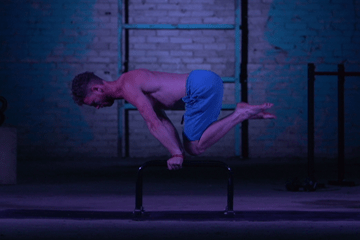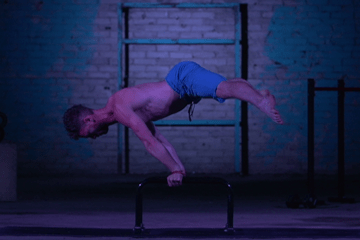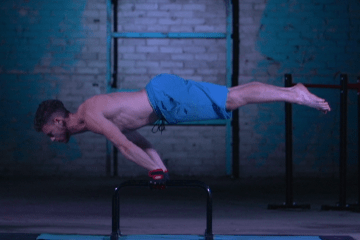About this Progression
Planche is a strength-based full-body skill move that originated from gymnastics. Oftentimes, it leaves people in awe with its gravity-defying aesthetic.
Whether you’re learning the full planche in calisthenics or gymnastics approach, you’ll basically need the same thing: proper progressions and specific conditioning.
An effective planche training routine is one that is progressive in nature; you should start with the easiest possible progression of exercises before graduating to more difficult ones. This will allow your body time to adapt and build itself up slowly.
As a beginner in the planche journey, it’s important for you to be able to hold each step for at least 10 seconds before progressing onto the next exercise.
Ideally, the feet should be hovering off the ground, but you can also let your feet touch the ground for additional support while still lacking push power.
First thing’s first: the fundamentals
But first, beginners must master the fundamental of calisthenics before entering the planche journey.
While it is possible to skip the fundamentals, it wouldn’t be the wisest decision.
Bodyweight training fundamental build a solid foundation so you can progress into more advanced skills, such as the planche, in a more efficient and safer manner.
The planche journey is a frustrating path itself given its high level of difficulty. But lacking the basics will further widen the gap between you and the planche since you didn’t have basic requirements to start the journey.
So before you get cracking with planche work, COMPLETE YOUR BASICS FIRST.
If you’re just beginning with your calisthenics journey, we highly recommend checking out this article first:
Interested in calisthenics but don’t know where to start?
What are progressions?
We talk about the need for progressions but what are they anyway?
Progressions are sets of exercises needed to learn a specific movement. In our case for today, it’s the planche.
To master the planche, you need to go through every exercise in the progression.
You can read more about progressions, why it is a crucial element for calisthenics growth, and why The Movement Athlete tasks advantage of this in the article below:
Progressions: The Movement Athlete’s Bread and Butter
Why follow a progression?
Progression is the counterpart of adding weight to weight lifting.
With your traditional weight training, you simply add more weight to make the exercise harder every session.
With bodyweight training, we use progressions we take advantage of the laws of physics to adjust the difficulty of an exercise.
To do that either change our body position, the angle or move to unilateral work to put our bodies in a more mechanically disadvantageous position. This increases the difficulty of the exercise.
Here are more reasons why we follow a progression:
- Prevent injury by safely bridging skill gap
- Increase body strength gradually
- Teach correct technique
- Build proper habits for faster skill acquisition
As you can see, progressions are vital for planche or any bodyweight or even gymnastics exercise.
General rules for all planche variations
The exercises we’re going to share are mainly planche variations. This means that most of the variations follow a general guideline in terms of form and technique.
These are musts for all variations and should be ingrained in your mind every time you are attempting any planche position.
- Straight body line
- Lockout arms
- Elbows externally rotated
- Upper body to waist parallel to the ground
- Protracted scapula
- Depressed shoulders
- Consistent placement of hands
- Enough forward lean for the corresponding variation
- Rely on lean for balance
- Full-body tension
- Feet pointed
- Avoid overarching of the upper back
- Master previous step before attempting a harder variation
These cues are non-negotiable. If you want to achieve a perfect planche hold efficiently, safely, that passes the gymnastics standards of form, remember these cues.
Do them. You can train them separately. But when attempting a planche, do them all together.
Ideal hand placement
When running through the list of variations, it’s best to train a single-hand position. This will help you progress faster and more consistently rather than changing your hand placement from time to time.
Hands should be shoulder-width apart or very slightly wider apart. Anything wider or more narrow will feel a lot heavier.
For hand position, you have three options.
Hands forward – More stress on wrists. More control with fingers
Hands backward – Less stress on wrists. More stress on arms and elbows.
Hands at 180 degrees – Less stress on wrists. Less control.
Hands at 45 degrees – Balance between control and stress on the wrist.
Which one should you choose?
It still depends on your individuality. Try out placing the hands in different positions with a simple planche forward lean to feel which feels the most comfortable.
What should be my focus?
Learning planche you need specificity. It requires specific attention on exercises that help you progress towards planche.
Here’s what these holds help you with.
Shoulder development in the leaning position
In order to balance your whole body parallel to the ground with just your arms, you need extreme upper body strength in a very awkward position.
Overhead pushing exercises like pike push-ups or handstand push-ups are good for developing generally strong shoulders, but for planche work, it is not enough.
Elbow & wrist conditioning
As you might notice, we don’t usually do straight-arm work such as the planche. Our elbows and wrists are not used to this position which is why it might feel very awkward at the beginning of your planche journey.
Keeping your arms straight is a vital step in the planche journey. Getting stronger muscles is important, but joint conditioning also is essential to hold the planche positions as well as help you avoid any nasty injury.
General strength work
Having a strong general push strength sets an excellent foundation when you work towards the specific demands of planche. While it doesn’t necessarily mean you’ll get planche easily if you have so much pushing strength, it does provide a major advantage. Lacking good general strength bars you from maximizing your planche-specific capabilities.
Balanced training
Push is important, but don’t forget about pull. Pull-ups and rows at least once or twice a week in conjunction with your planche workout free you from imbalances that might hinder your maximum performance.
Planche progression
There are a few different progressions you can use to train to get into the planche position.
It’s not necessary to hold for 30-seconds for each exercise, but our aim here is to get strong enough and master the techniques to move further up in the planche journey.
Keep in mind that there is another set of progressions to get to tuck planche from 0 which involves other moves such as frog stand and planche leans to prepare your body for the primary planche journey.
PLANCHE PROGRESSION
Level
Intermediate – Advanced
Goal
To master planche

Tuck Planche
Step 1 in the planche journey is the tuck planche. It’s basically a planche with your knees tucked close to your chest to lessen the lever. It might not seem much, but it is still very challenging and is quite a remarkable achievement as well. In reality, the tuck planche might not yet be attained with perfect form on your first try, but you can let your feet first support you on the ground to lessen the load. You can also use resistance bands to add additional support to get a feel of the position.


Advanced Tuck Planche
The next step is the advanced tuck planche. At first glance, you might notice that the main difference is the different positions of the legs. The very slight adjustment of the tucked knees will add so much weight to your lower body. The key here is to lean forward enough so you can balance the position and rely more on your upper torso. Instead of focusing on extending your legs backward, lean forward even more first. Once you’ve lean enough, you will be able to move your hips as your next step.

Frog Planche
Frog planche is basically an advanced tuck planche but with legs apart. This will you get a better feel of the planche since you’re pretty much near the straddle planche at this point. Knees are still bent and tucked close to the chest but hips are in an open position which adds more loading on your core.

Piked Straddle Planche
Pike straddle planche looks like a straddle planche with bad form, but it’s actually a good progression to build up strength towards the much harder variations. Legs are now extended and straight, but hips are piked similar to the advanced tuck planche. It’s best to practice this hold on parallettes instead of the floor to make room for the extended legs.

Straddle Planche
Lean forward even further as the hips extend backward to achieve the straddle planche position. Aim to get your whole body parallel to the ground. The straddle leg position keeps the weight outwards requiring you less of the lean compared to a full planche.

One Leg Planche
One knee is tucked close to the chest similar to a tuck planche while the other one is extended. This is a unilateral exercise so be sure to switch the legs every attempt.

Half-lay Planche
This progression is almost a full planche with the same body alignment. The only difference is the bent knees which lessen the loading. Once you extend your knees, you will be in the final step.

Full planche
Time to push your body to the limit with the final step in this training series. Aim to lean far enough and fight the urge to face plant on the ground. Once you reach the sweet spot, you will be able to balance easily and your legs will lift off the ground like it’s nothing. Keep in mind all the cues and perfect form to properly execute the movement.
Supplementary but Essential Exercises
While the progression is essential to planche training, it’s not the only thing that matters in the whole planche journey. Progression is just one part of the equation.
These are essential exercises that help you build straight-arm strength, joints, and body conditioning.

Pseudo Planche Leans
A crucial exercise from beginners to advanced planche-lovers because of its scalability and simulation of body hold for planche. For beginners, this is great for conditioning the shoulders and elbows for entry to tuck planche. It could also be step 1 in a beginner’s planche journey. For more advanced athletes, the exercise helps to get a further learn for more advanced variations.

Pseudo Planche Push-ups
This bent arm work translates also to straight arm training and builds stronger shoulders, arms, and chest for further planche leans. Psuedo planche push-ups can also be scaled to any level. What matters in the exercise with straight arms at the top position and leaning properly during descent and lift up.

Frog Stand (crow stand)
For beginners who are not quite there yet with lockout elbows, frog stand is an excellent exercise to get a feel of balancing your body on your hands while feet are off the floor and build shoulders strength for the upcoming challenge: the tuck planche. The frog stand also teaches how to use your hands for balance corrections.

Leg Extensions
To practice the lower body component, leg lift and extensions are a necessity for core strength and technique development. This exercise helps you familiarize how to use your legs when performing the movement. The lower back is also strengthened which is an essential part of your core.

Resistance Band Variations
The lift to planche and hold for a time optimal to stimulate growth with the proper progression can sometimes be too demanding. Adding assistance from bands to bridge the gap and begin training the right muscles for the planches. This is also a good option for beginners who are just learning tuck planche or trying to transition to advanced tuck planche since t Just be sure to use the least possible assistance from the band. You can anchor your bands on bars or beams above you.

Planche Push-up Variations
Learning how to perform a hold is one thing, adding the concentric and eccentric phase is another beast. But including a push-up variation (even if you use a band) adds more pushing power for you to further hold the planche.

Straight-arm Dumbbell Raises
Nothing wrong with additional weight training to isolate the arms, elbows and target the shoulders. The movement pattern mimics the planche motion while minimizing injury. Hands can be placed depending on comfortability. Use free weights or dumbbells whichever is accessible. Move slowly to promote the growth of your muscles.
Where to practice planche?
Floor – Training on the floor opens many opportunities for other transitions and lets you get more control using your fingers.
Parallettes/ P – bars – This is ideal to lessen stress on the wrist.
Gymnastics rings – Anything done on gymnastics rings are crazy stuff because of the innate instability of the rings. Consider planche on gymnastics rings when you already have mastered the full planche or at least the straddle planche on the floor or parallettes.
How often should you train planche?
Learning the planche can be a high-intensity workout and should therefore be done in moderation. Moving on to other exercises, if desired, will help you build upper body strength without fatiguing your muscles too quickly. Two to four days of working on planches are enough. Resting or doing pulling and legs can be done on the other days for proper recovery of the body.
Take a video of yourself
If you’re training alone, filming yourself is a great way to know if you’re properly performing the planche.Learning
To summarize this article:
If you have decided to work your way through this progression, stay consistent and trust the process. It’s a long, but very rewarding journey when you finally achieve the planche!
Planche is not a test, but a journey to build strength and skill.
The faster, more efficient, and safer route to training planche differs from person to person. This is why a PERSONALISED and ADAPTIVE training program works best.
To get start on personalisation, the first step is knowing where you are.
Begin with the assessment below so you can take the smarter step to learn the planche.
Take the assessment now!






